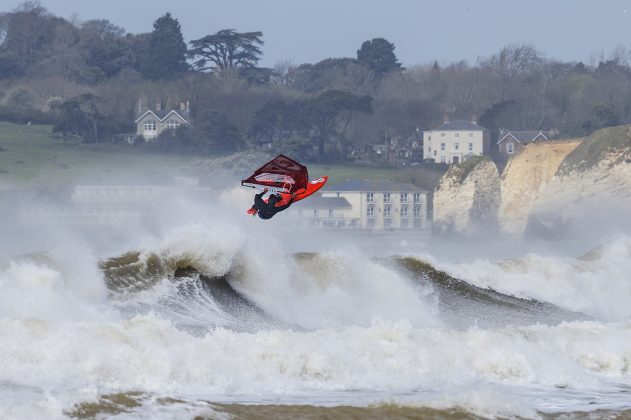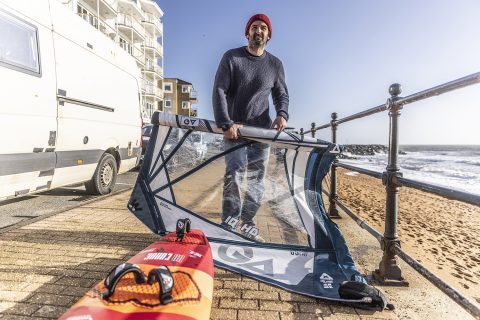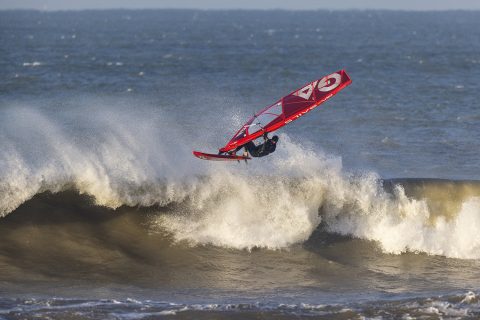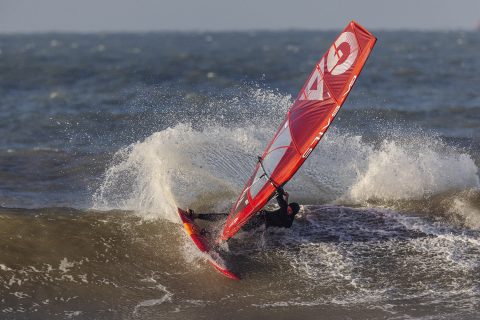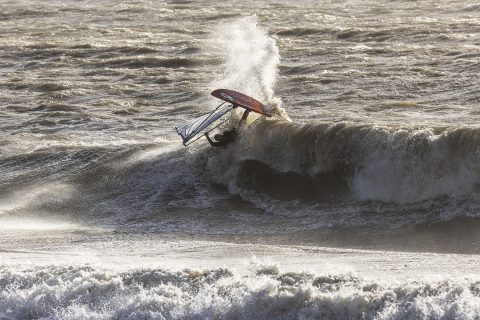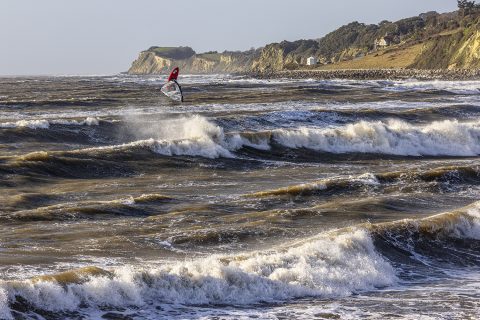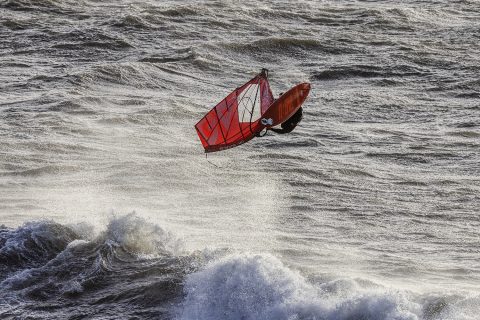ROSS WILLIAMS: ROSS TIPS
Following on from last month’s teachings, Isle of Wight wave wizard, Ross Williams, gives some top tips to help improve your turns and air game!
Words: Ross Williams // Photos: John Carter.
How well you have executed your bottom turn and your timing will often decide what kind of manoeuvre you can do at the top of the wave. Maybe you’ll be hitting a closeout section, boosting an aerial or simply carving a cutback before you set yourself up for the next bottom turn.
- Ross Williams
Because you are leading with your head, you are able to see within that bottom turn what you should be planning to do when you hit the lip. I normally try to find the most radical part of the wave, especially when I am free sailing. In a competition, you need to rack up a few points rather than just one manoeuvre so you make the most of the whole ride to achieve the highest score that you can. But you still have to be as dynamic as possible. The bottom turn basically dictates what you are able to do on the wave and is a critical element of wave sailing to master.
- Ross Williams aerial
Aerials
If there is no other option than to do an aerial, I would just say don’t hold back and go for it. Hold on to your boom, because if you do get your timing wrong and you are too late, the last thing you want is to not be able to get your feet out of the straps. Hold onto the boom so you are still connected to your equipment. If you have a bad wipeout, once your feet are out of the straps, then you can let go of the boom. I always try to hang on to the boom and it is always the last thing I will disconnect from if I do wipe out.
I love aerials as well as wave riding. Probably in a contest some sort of big air will look more dynamic and be considered more as the move of the day. In a side-shore crumbly wave you are going to be looking to do more powerful top turns than big airs, whereas if it is cross-offshore with a big hollow bowling lip in front of you, then the air might be your only option. For cross-shore you are looking at more fins out and power carves when you hit the lip, rather than concentrating on your timing for airs. Guys like Josh Angulo are power sailors. He still does great manoeuvres. Where he sails, you need to boost huge aerials to make the sections so you can also throw down some turns. If you don’t throw an air at breaks like Ponta Preta when you are too deep then you are going to end up coming in on the rocks.
- Ross Williams top turn
Top turns
For a decent top turn I like to engage the fins and the rails. Brawzinho to me has the best top turn in the business. He just possesses such good timing and has such a powerful style. He puts his board on the rails from the start to the finish of the turn. He comes all the way round and finishes the manoeuvre really well. He sends buckets of spray. He does not slide out, he can slide out, but he is in control. Some sailors do a top turn and slide at the end of it, but without sending spray. I think that is lame. Power over slide for me is much more credible.
The first part of the turn, I am using my back foot to do the work, but as I am finishing the turn, depending on how much of the rail of the board is in the water, that defines how much weight I can transfer from my back foot to the front foot. I think sailors that do really good top turns use both feet, fluidly moving from the back to the front foot. I use an overhand grip on my boom, I don’t know if there is a right or wrong way to hold the boom, but that is what I have gotten used to.
- Wave 360 from Ross Williams
Wave 360
There are variations on wave 360s, but the most impressive ones I think are the ones that where you are coming in late and folding back over the top of the lip and landing back into the flats. There are the ones that feel the best to me because you complete the rotation in the air. The ones where guys slide around and then flop over are not as dynamic. I prefer the ones where you can see the bottom turn is timed perfectly and you hit the section which then helps propel the manoeuvre around.
Directions
Dead onshore is what I don’t like. I don’t really enjoy sailing when a wave is not coming straight at me, but he more you sail in certain conditions the better you get. If onshore is your only option, you soon get used to sailing those conditions, you will improve and you will enjoy it. I like cross-offshore more when it is on my natural tack, which as a goofy foot surfer is port tack. It’s more comfortable and my sense of timing feels better on that tack than on starboard. In side-shore it is similar as well. You are probably always going to have a stronger tack. I am fortunate because the majority of my sailing at home on the Isle of Wight is in starboard tack conditions, which is my weaker side. I feel I can sail quite well on starboard, but when I do get the chance to sail port, it comes more naturally. I don’t need to practise port tack as it just comes more naturally for me through surfing.
- Ross Williams back loop
Jumping
If you are looking to improve your jumping, then try and give yourself a decent run up. Try to come upwind a bit more so you are enabling the best chance to pick up speed and direct yourself towards the ramp you want. So ideally you will be on a bit more of a broader reach than you would do when normally heading out. That way you are able to navigate the path to the impact zone where the wave / ramp is going to be peaking with as much speed as possible. When trying to learn the push loop and back loop, a lot of the time, having the speed and hitting the steepest part of the ramp will make it easier to land the move. You are not forcing the move round in the air, which you might have to do off of a shallow ramp. Having speed, going off the wind and then jumping up off the steepest part of the wave, rather than straight, is key.
Back loop
Hit your ramp full speed and go up as vertical as possible. Hitting a flatter ramp is going to make your rotation spin round a bit more. It is better to go up vertically so you have more time in the air. At the apex of the jump, you are looking back over you neck and spotting the landing. At the same time you move your back arm back on the boom to control your sail and bring it in close to your body and keep it less exposed to the wind. You don’t want the sail to be powering up as you are coming back down to spot your landing. You want to keep it close to you and away from the wind, so that you can land and then release the power out of the sail. I try to land nose first. A really nice one is when you drop out of the sky, spot the landing and you just come down almost ready to plane out of it.
- Ross Williams push loop
Push loop
I think the push loop is the easiest back rotating jump to land for me. Again you want to be going fast, speed is the key. Then you are not forcing anything as you go up into the air. So speed, a steep ramp and not going too far up into wind are my basic tips for a push loop. Do your rotation more vertically and then when you flick your head back, it will send you into a controllable spin rather than taking you up into wind and over-rotating.
So my main jump tips for these two moves are hitting a steep ramp with good speed and instead of going up and out, try to send it upwards more vertical and then down. If you jump out of the ramp, your rotations tends to spin faster and you don’t get that time in the air to eye your landing. Going up helps you control jumps better and you don’t get so disorientated in the air.
I love the feeling of a push loop. If you have not jumped for a while, I think the push loop is a nice way to get you into that feeling of rotating in the air. It is the one that feels the most comfortable to let go of the gear in if I don’t feel it going to plan.
I think with the push loop, once your mast has cleared the top of the wave, you can almost throw your head back straight away. With the back loop, you kind of wait until the apex of your jump or on a really big one, you wait until you start coming down to look over you shoulder at the landing.
On the push loop, when you are learning, you should try and spot your landing as soon as you take off. You flick your head back and spot the landing over the tip of your mast. So you throw your head back and focus on the tip of your mast. Then you will see the water below you, sense the landing and guide it down. You can almost finish your rotation on a push loop as you get to the top of your jump. That way you can control your landing by floating down a little bit more. Throwing your head will bring you closer to your boom and you naturally sheet in at the same time, while you are looking up to the top of your mast. Without realizing it, the rest of your body is following the motion that you need to get the rotation and nail the landing.
Practise
I think the biggest tip I can give to a keen rider who wants to improve their wave sailing is to practise and go out as much as possible, even if the conditions are not amazing. If you are in the UK it can be hard to motivate yourself in the winter when the conditions are not that special, but more time on the water pays off. Try and do what you can to make those conditions more enjoyable, starting with making sure that you have a dry wetsuit. No one wants to get into a wet wetsuit when the conditions are really average. If you have a nice dry toasty wetsuit, then boom, you are already going into the water feeling more positive. Also make sure all your preparation before that session is in place. Check the conditions, watch the sets, and try to pick the right wave.
I also like to watch a lot of Instagram clips, which help give me inspiration and motivation to try new things. I like watching Brawzinho, Polakow, Levi Siver, Thomas Traversa and Robby Swift. All those guys I look up to and make me want to improve my own style on the water.

